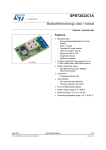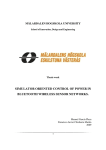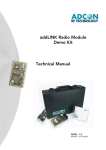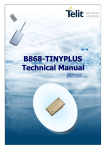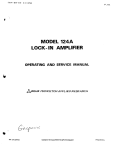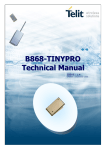Download Adeunis RF Vokkero BasiX User guide
Transcript
ARF62 Bluetooth® Class1 RS232 Dongle User Guide No part of this document may be reproduced or transmitted (in electronic or paper version, photocopy) without Adeunis RF consent. This document is subject to change without notice. All trademarks mentioned in this guide are the property of their respective owner. ADEUNIS RF 283, rue Louis Néel 38920 Crolles France Phone Fax +33 (0)4 76 92 07 77 +33 (0)4 76 08 97 46 Ref. 11-07-V3-ffr ARF62 User Guide Table of Contents Table of Contents .............................................................................. 1 About this Document ........................................................................ 2 Declaration of conformity ................................................................. 3 Compliance to FCC US/CAN .............................................................. 4 Overview ........................................................................................... 5 Interface ........................................................................................... 6 Mechanical specification ..................................................................... 6 Power supply input ............................................................................ 6 External Power Supply & RI Power Supply ........................................... 6 Signal description .............................................................................. 7 Profiles .............................................................................................. 7 SPP wiring and configuration .............................................................. 8 DUN wiring and configuration ............................................................. 9 Dongle operating mode .................................................................. 10 Command mode .............................................................................. 10 Transparent mode ........................................................................... 11 Remote control configuration ......................................................... 11 AT Commands ................................................................................. 12 Description ...................................................................................... 12 Set of commands ............................................................................. 12 Register description ......................................................................... 14 Specifications .................................................................................. 18 Annex 1 : Firmware and document updates ................................... 19 Ref. 11-07-V3-ffr p1 ARF62 User Guide About this Document This guide describes the ARF62 devices, their options and accessories. Ref. 11-07-V3-ffr p2 ARF62 User Guide Declaration of conformity Manufacturer’s name: ADEUNIS R.F. Manufacturer’s address:Parc Technologique PRE ROUX IV 283 rue Louis NEEL 38920 CROLLES - FRANCE declares that the product if used and installed according to the user guide available on our web site www.adeunis-rf.com Product Name: Product Number(s): ARF62 ARF7501B/ARF7502B/ARF7503C/ARF7509A is designed to comply with the RTTE Directive 99/5/EC: EMC: Safety: Radio: according to the harmonized standard EN 301 489. according to the standard EN 60950-1/2001 according to harmonized standard EN 300-328 covering essential radio requirements of the RTTE directive. - Conformity has been evaluated according to the procedure described in Annex III of the RTTE directive. - Receiver class (if applicable): 3. Notes: Exposure to radio frequency signals, according to the 1999/519/EC recommendation, minimum distance between the product and the body could be required depending on the dongle integration. Crolles, December 5th, 2008 VINCENT Hervé / Quality manager Download of the user guide Thank you for having chosen the ADEUNIS RF products. User guides can be uploaded directly on our web site www.adeunis-rf.com Index Products Paragraph Bluetooth® solutions > 'Ready to use' Bluetooth® products Print version available upon request Tel : +33 4 76 92 07 77 Email : [email protected] Ref. 11-07-V3-ffr p3 ARF62 User Guide Compliance to FCC US/CAN This equipment has been tested and found to comply with the limits for a Class B digital device, pursuant to Part 15 of the FCC Rules. These limits are designed to provide reasonable protection against harmful interference in a residential installation. This equipment generates, uses and can radiate radio frequency energy and, if not installed and used in accordance with the instructions, may cause harmful interference to radio communications. However, there is no guarantee that interference will not occur in a particular installation. If this equipment does cause harmful interference to radio or television reception, which can be determined by turning the equipment off and on, the user is encouraged to try to correct the interference by one or more of the following measures: -- Reorient or relocate the receiving antenna. -- Increase the separation between the equipment and receiver. -- Connect the equipment into an outlet on a circuit different from that to which the receiver is connected. -- Consult the dealer or an experienced radio/TV technician for help. CHANGES OR MODIFICATIONS NOT EXPRESSLY APPROVED BY ADEUNIS RF COULD VOID THE USER’S AUTHORITY TO OPERATE THE EQUIPMENT. RF Exposure Warning: During operation, the user may keep a minimum separation distance of 20 cm with the RF devices. Ref. 11-07-V3-ffr p4 ARF62 User Guide Overview The ARF62 Bluetooth class 1 dongle enables Bluetooth® compliant duplex communications over a 150-meter range in the worldwide 2.45 GHz frequency band. The ARF62 dongle fully complies with the V2 Bluetooth® standard and air data rate goes up to 723 kbps. Data exchange and set-up are only done through an UART data port, under SPP or DUN profile. A miniature antenna is integrated. ARF62 can be used in two modes: command mode and transparent mode. The command mode is used to established Bluetooth communications and set/get parameters. The transparent mode is used for data exchange. The dongle converts data from a serial link into a Bluetooth® radio frame to be sent to a similar piece of equipment. The communication is half-duplex. The operating parameters of the Bluetooth dongle (serial link, Bluetooth® management…) can be fully updated through AT commands via the serial link. We recommend reading the “specification of the Bluetooth® system core 2.0 + EDR” document available at the www.bluetooth.com web site. Ref. 11-07-V3-ffr p5 ARF62 User Guide Interface Mechanical specification 65 x 40 x 25 mm Power supply input ARF62 dongles may be supplied using an external power supply through µJack plug (default) or through RI pin / DB connector. Selection is done with an internal onboard jumper: External Power Supply Ref. 11-07-V3-ffr RI Power Supply p6 ARF62 User Guide NOTE : ARF62 external power supply is done through a female ∅3.5 mm DC µJack (Positive on inner pin ∅1.3 mm) Signal description ARF750X Bluetooth Dongles pinout. Interface Pin ARF7501 Fem DB9 DCE 5 3 (I) 2 (O) 8 (O) 7 (I) 4 (I) 6 (O) Interface Pin ARF7502 Mal DB9 DTE 5 3 (O) 2 (I) 8 (I) 7 (O) 4 (O) 6 (I) Interface Pin ARF7503 Mal DB15HD DTE 9 2 (O) 6 (I) 11 (I) 12 (O) 8 (O) 7 (I) GND TXD RXD CTS RTS DTR DSR 9 (O) 9 (I) 13 (I) RI 1 (O) 1 (I) 1 (I) DCD Name Description Digital interface Ground Serial data transmission Serial data reception Clear To Send Request To Send Data Terminal ready Data Set Ready Ring Indicator / (DC Supply Input -if selected-) Data Carrier Detect Profiles The dongle supports 2 different profiles: SPP and DUN. A basic dongle configuration is provided as a guideline for each profile (for more details or customisation see § AT commands). The dongle can be configured using a terminal at 9600 baud, 8 bits, 1 stop, HW flow control (default serial configuration) Ref. 11-07-V3-ffr p7 ARF62 User Guide SPP wiring and configuration SPP (Serial Port Profile) is the standard Bluetooth® profile. GND PC (DTE) RI DTR RTS RD CTS TD DSR DCDRI GND RI DTR CTS TD RTS RD DSR DCD GND ARF62 Bluetooth Dongle ARF62 Bluetooth Dongle Master Slave RI DTR RTS RD CTS TD DSR DCD GND RI DSR CTS TD RTS RD DTR PC (DTE) DCD SPP configuration guideline : in the following example, the Master is configured to performed an auto-connection on reset. Master configuration : enters the command mode using the A+++ sequence. When the <OK> answer is receive, send the following commands : ATS202=1 (auto-connect on reset) ATS220=1 (SPP profile, default value) ATS203= slave BT address (use ATINQ 0,10 command to discover the slave @) AT&W (save the configuration) Slave configuration : enters the command mode and then send the following commands : ATS202=0 (auto-connect disable, default value) ATS220=1 (SPP profil) AT&W (save the configuration) Perform a power cycle on both dongles. The dongles are now in transparent mode; the link will be established automatically on reset by the master. When the link is established data can be exchanged using the serial link. Ref. 11-07-V3-ffr p8 ARF62 User Guide Caution the BT connection establishment can takes several seconds (you can check this establishment in command mode using the AT&L command). DUN wiring and configuration DUN (Dial up Network) profile is above the SPP profile. This profile manages the 4 lines DTR, DSR, DCD and RI and is dedicated to PSTN or GSM modems. PC (DTE) GND GND GND GND RI DTR RI DTR RI DTR RI RTS CTS RTS RD TD CTS RTS TD RD DSR DSR DCD DCD ARF62 Bluetooth Dongle Master ARF62 Bluetooth Dongle Slave DTR RD RTS RD CTS CTS TD DSR TD DSR DCD DCD Modem (DCE) DUN configuration guideline : in the following example, the Master is configured to performed an auto-connection on DSR. Master configuration : enters the command mode using the A+++ sequence. When the <OK> answer is receive, send the following commands : ATS202=2 (auto-connect on DTR) ATS220=2 (Dun profile) ATS203= slave BT address (use ATINQ 0,10 command to discover the slave @) AT&W (save the configuration) Slave configuration : enters the command mode and then send the following commands : ATS202=0 (auto-connect disable, default value) ATS220=2 (Dun profile) AT&W (save the configuration) Exit the command mode or perform a power cycle on both dongles. The dongles are now in transparent mode; the link will be established when the Ref. 11-07-V3-ffr p9 ARF62 User Guide DTR is activated on the master. When the link is established data can be exchanged using the serial link. Caution the BT connection establishment can takes several seconds (you can check this establishment either in command mode using the AT&L command or by checking report of a remote signal). DTR/DSR/RI and DCD I/O configuration : These lines are set as inputs while the connection is not established or released, And set as input and output according to the DUN illustration and to the description done in signal description table. Dongle operating mode Two operating modes are available: - Command mode (usage of AT commands and SPP_CONFIG mode), - Transparent mode (serial data are transmitted on radio link). At power up, the dongle is in transparent mode according to the registers configuration. The boot time is about 1s. Command mode The command mode is used to read and update the dongle configuration registers using AT commands. In command mode, the radio is inhibited (reception and transmission), excepted when using test command. Entering command mode : issues on the serial link a A+++ sequence. The sequence A+++ characters is accepted only if no character has been seen before and after the A+++ sequence. Register (S214) defines the silence duration. Tips : if you are using a terminal (such as Hyperterm), you have to send the A+++ sequence using a text file (first create a text file containing only the A+++ characters, and then use in Hyperterm the command “Send text file” in the “Transfer menu”) Ref. 11-07-V3-ffr p 10 ARF62 User Guide Exiting command mode (return back in transceiver mode) : send the serial command ATO <cr> Transparent mode In transparent mode, data received from the serial link are transmitted on the radio link. When data are received on the radio link, these data are sent on the serial link. Remote control configuration SPP_CONFIG mode is used to remotely configure the slave dongle through the master dongle serial link. RS232 ARF62 Bluetooth DCE Dongle Master ARF62 Bluetooth DTE Dongle M1 slave This is done, on master side, in 4 steps: Activation of the SPP_CONFIG mode using the ATC1 command. When this mode is activated, the command issued on the master will be ignored by the master and transmitted to the slave by radio. Slave configuration: send command to the slave using the Master serial link. When the remote configuration is done, the master must sent an AT&W command to the slave (the AT&W command is mandatory because the slave reboots when the master leaves the SPP_CONFIG mode or when the RF link is loosed). Leaving of the SPP_CONFIG mode using the ATC0 command. Ref. 11-07-V3-ffr p 11 ARF62 User Guide AT Commands Description AT commands are interpreted only when the dongle is in Command mode. Commands : are used to read and update the dongle parameters A command starts with the 2 ASCII ‘AT’ characters. ‘AT’ means ‘Attention’ follow with one or several characters or other data. Each command is ended with <cr> (carriage return). In the same command, the time between 2 characters must be less than 10s. Response : is sent back for each command on the serial link. The answer is: • <cr><lf ‘OK’<cr><lf> (ASCII character 0x4F) for accepted command (or OK command) • <cr><lf ‘ERROR’<cr><lf> for error • Specific string when specified Set of commands The SPP CONFIG column indicates whether the command is available or not when the dongle is in SPP CONFIG mode (ATC1 command). Ref. 11-07-V3-ffr p 12 ARF62 User Guide Commands Description SPP CONFIG Operating mode selection ATO <silence>A+++ <silence> Return back to transparent mode. Command mode activation. The A+++ sequence must be preceded and followed by a calibrated silence (no other character) ATC0 Registers management Displays the Sn register content where n represents the register number. The response has the following format: Sn=y<cr><lf> Sets the Sn register value with ‘m’. n represents the register number.. Saves the new register configuration in EEPROM. Each time you switch on the modem, the EEPROM configuration will be loaded in the modem registers. Displays all register values. The response has the following format: Sxxx=y<cr><lf> for each register. Restore register default values (Refer to Annexe 1 – Page 19) BT LINK management Launch Bluetooth inquiry of devices for a duration d multiple of 1.28s <1..48>, for maximum n (0=unlimited, 1= one device, …) devices Return BT address and class of device of each peripheral Example : ATINQ 0,10 Establish Bluetooth link with device <Bluetooth address> Link established : answer ‘OK’<cr><lf> Link not established : answer ‘NO CARRIER’<cr><lf> Example : ATD 0018B2000110 Release Bluetooth link Link connection status. released or established RSSI indicator Link established : answer -xx dBm<cr><lf> (-45 dBm for example) Link not established : answer ‘LINK RELEASED<cr><lf>’ RSSI > -70 dBm : Excellent receipt -70 > RSSI > -80 dBm : Good receipt -80 > RSSI > -90 dBm : Poor receipt RSSI < -90 dBm : Bad receipt Miscelleanous Software version display. The response has the following format: Adeunis RF : 7456 Vxx.yy<cr><lf> Exit SPP Config mode ATC1 Enter SPP Config mode ATSn? ATSn=m AT&W AT&V AT&F ATINQ<space>Ma xDevice, TimeOut ATD<space>Blueto oth address ATH AT&L AT&RSSI ATI NO NO YES YES YES YES YES NO NO NO NO NO YES YES NO Test modes Ref. 11-07-V3-ffr p 13 ARF62 User Guide AT&T0=xxxx,yyyyy, zzzzz AT&T1=xxxx, yyyyy AT&T2=x, yyyyy AT&T3=xxxx,y,zz AT&T4=xxxx, yyyyy Continuous transmission at xxxx (2402<=xxxx<=2480) MHz, with a designated output power yy (0<=yyyy<=65530) and designated tone modulation frequency zzzzz (0<=zzzzz<=65535). Example : AT&T0=2450,65530,0 Enables the transmitter at xxxx (2402<=xxxx<=2480) MHz, with a designated output power yy (0<= yyyyy <=65530). Payload is PRBS9 data. Example : AT&T1=2450,65530 Enables the transmitter with a simplified hop sequence designated by the country code x (0<=x<=3), with a designated output power yy (0<=yyyy<=65535). Payload is PRBS9 data. Example : AT&T2=0,65530 Enables the receiver in continuous reception at xxxx (2402<=xxxx<=2480) MHz, with a choice of low (y=0) or high (y=1) side modulation and a designated attenuation zz (0<=zz<=15). Example : ATT&T3=2450,0,0 Test loopback at xxxx (2402<=xxxx<=2480) MHz, with a designated output power yy (0<= yyyyy <=65530). Example : AT&T4=2450,65530 NO NO NO NO NO Register description The register value could be updated using the ATSn=m<cr> command and displayed using Aton?<cr> command. At power-up, the previous dongle configuration is read from E2PROM (non volatile) and stored in RAM. The registers are located in RAM, any modification is performed in RAM: To save current register configurations, it is necessary to use the AT&W<cr> command (If not, the updated parameters are lost in case of power shortage). The registers are shared in 2 types: read only (R) or read/write (R/W) Ref. 11-07-V3-ffr p 14 ARF62 User Guide Type Register Function R S200 Local Bluetooth address R/W S201 Local device name R/W S202 Auto-connect mode R/W S203 Remote Bluetooth address R/W S204 reconnection management R/W S205 Pin code R/W S206 R/W R/W Description Bluetooth management Local Bluetooth address of the dongle The local BT address is read only. Device name must be lower or equal than 32 bytes Auto-connect mode : 0 = disable 1 = Auto-connect on reset or power up 2 = Auto-connect on GPIO (DTR) Remote Bluetooth address used with auto-connect mode enabled. Reconnection management used with auto-connection mode Send ‘NO CARRIER’ <cr><lf> in case of no connection 0 : no reconnection N : number of retries (N<>0 and N <>255) 255 : always Default value Link disconnection if register value change NO “Serial Port Device” YES 0 YES 000000000000h YES 255 YES Pin code of the dongle must be lower than or equal to 16 bytes 0000 YES Encryption Encryption type : ‘0’ = disabled ‘1’ = enabled 0 YES S207 Security 0 YES S208 Class of device Security type : ‘0’ = disabled the pin code demand ‘1’ = enabled the pin code demand 0xXXXXXX 000000h YES Ref. 11-07-V3-ffr p 15 ARF62 User Guide Type Register Function Description Default value R/W S210 Baudrate Serial link rate in bits/s IMPORTANT see Note 1 ‘4’: 9 600 ‘5’: 19 200 ‘6’: 38 400 ‘7’: 57 600 ‘8’: 115 200 ‘8’ : 8 bits, see Note 1. see Note 1. ‘1’ : none ‘2’ : even ‘3’ : odd see Note 1. ‘1 ‘ : 1 stop bit ‘2’ : 2 stop bit Time out duration for detecting the A+++ pattern, unit 1/50s (20ms) : from 1 up to 255x50ms. 4 R/W R/W S211 S212 Data length Parity R/W S213 Stop bits R/W S214 Command timeout R/W S215 Flow control R/W S220 Protocol R/W S230 Low power modes R/W S231 Sniff parameter Max interval Ref. 11-07-V3-ffr Flow control management : 0 : disable (RTS/CTS management) 1 : enable (RTS/CTS management) Modifying is enable after ATO command which reboot the system. Protocol ‘1’= SPP ‘2’= DUN 0 : not used 1 : Hold Mode : very low power and low throughput 2 : Park Mode : low power and medium throughput 3 : Sniff Mode : low power and maximum throughput 4 : User sniff mode (Bluetooth expert only) – use parameters S231..S234 see Note 2. 6..1344 Wake-up duty cycle (Tsniff) – multiply 625us Link disconnection if register value change NO (See Note 1) 8 1 NO NO 1 NO 50 NO 1 NO 1 YES 0 YES 800 YES p 16 ARF62 User Guide R/W S232 Sniff parameter Min interval R/W S233 Sniff parameter Attempt R/W S234 Sniff parameter Timeout see Note 2. 0..1342 Sniff offset (Dsniff) – multiply 625us Dsniff must be lower or equal to Tsniff-2 0..672 Number of slots listen by slave during wake-up Sniff parameter attempt must be lower than Tsniff/2 0..40 Number of additional slots listen by slave during wake-up 80 YES 8 YES 8 YES The column “link disconnection if register value change” does not apply if the modification is done remotely (for a slave configured using the SPP CONFIG mode). NOTE 1 when changing the serial link configuration (rate, parity, stop bit…), the answer is done using the old serial link format, the next command must be sent using the new serial format. IMPORTANT : Firmware version dependant – Refer to Annexe 1 – Pg 22 NOTE 2 RUN SLEEP SLEEP Wake-up time Wake-up duty cycle Tsniff Ref. 11-07-V3-ffr RUN Dsniff p 17 ARF62 User Guide Specifications Embedded profiles Link set-up and status Radio rough data rate UART programmable format UART TTL ports Operating-mode RF radiated power Sensitivity Operating range (outdoor) Operating voltage Waiting for connection consumption Connected consumption Burst transmission consumption (max) Transmission consumption Operating temperature Storage conditions Dimensions Standards compliance GAP, SDAP, SPP, DUN Through Hayes commands 723 kbps Bluetooth radio rate bps Serial rate from 9600 bps to 921 600 bps TD – RD – RTS – CTS (& DTR-DSR-DCD-RI / DUN profile) Transparent 20 dBm (100 mW – Class 1) Up to -87 dBm for 10-3/PN9 Integrated antenna : up to 150 m 3,8 to 20 V < 22 mA (All RS232 signals used and connected) < 25 mA < 380 mA About 60mA (typical value in file transfer) -30°C / +70°C -45°C / +85°C (10 to 80% HR) 65 x 40 x 25 mm EN 300-328 / EN 301 489 References ARF7501A: Bluetooth® Class 1 RS232 DB9 DCE Dongle ARF7502A: Bluetooth® Class 1 RS232 DB9 DTE Dongle ARF7503A: Bluetooth® Class 1 RS232 DB15HD DTE Dongle ARF4013Z: DC Bloc for ARF62 external power supply 205058: DC Bloc ARF62 ∅3.5 µJack adapter Ref. 11-07-V3-ffr p 18 ARF62 User Guide Annex 1 : Firmware and document updates Firmware Updates ARF745XXB-V1.06 Firmware default data rate is now 9600 bps. Default data rate is 9600 bps and “Restore register default value – AT&F” gives data rate back to 9600 bps ARF745XXA-V1.05 Original version. Default data rate is set to 9600 bps but “Restore register default value – AT&F” will give data rate back to 115 kbps !!! Document Updates V2.0 Defaut data rate is now 9600 bps (Firmware version dependant!!!) V1.0 Documents’ layout and size V1.0 Original version Ref. 11-07-V3-ffr p 19





















